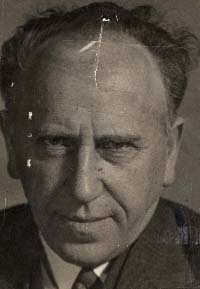Search for Names, Places and Biographies
Already layed Stumbling Stones
Suche
Prof. Friedrich Adler * 1878
Innocentiastraße 37 (Eimsbüttel, Harvestehude)
1942 Auschwitz
- http:/
/ de.wikipedia.org/ wiki/ Friedrich_Adler_(K%C3%BCnstler)
(Friedrich Adler bei Wikipedia) - http:/
/ www.zeichen-der-erinnerung.org/ n5_1_adler.htm
(Biographie Friedrich Adler bei 'Zeichen der Erinnerung')
further stumbling stones in Innocentiastraße 37:
Zerline Adler, Kaethe (Käte) Pincus, Martin Pincus, Abraham Sarfaty, Franziska Sarfaty, Joseph Sarfaty, Rosa Sarfaty, Israel Abraham Sarfaty, Annette Sarfaty, Ruth Klara Sarfaty, Benjamin Sarfaty, Henriette M. Schmid, Fritz Weinstein, Gertrud Weinstein
Friedrich Adler, born on 29 April 1878, deported to Auschwitz on 11 July 1942
Friedrich Adler’s creative vein became apparent already in his youth. He grew up in Laupheim close to Ulm and moved to Munich after having finished secondary school. In Munich he enrolled at the Royal Academy of Arts (Königliche Kunstgewerbeschule). In 1903 he directed one of the academy’s specialist workshops. Four years later – having completed his education – he moved to Hamburg and began teaching at the School of Arts (Landeskunstschule).
At this time, Friedrich Adler was already a popular artist. His work varied between Art Noveau, Neo-Classicism and Art Deco. He worked as a designer for more than 60 companies, designing forks, tea spoons, trays, floor coverings, household goods, plastics and entire interior furnishings. In Hamburg, Friedrich Adler married his Jewish fiancée Bertha Heymann. They had five children. The oldest, Hermann, was born on 14 Apr. 1908. The second son Max followed on 10 Mar. 19012, Max Wolfgang was born on 25 Nov. 1910, Ingeborg Elisabeth on 10 Mar. 1912, and Paul Wilhelm on 15 Feb. 1915. The youngest daughter Bertha was born on 22 Nov. 1918.
Friedrich Adler served as petty officer (Unteroffizier) during the First World War. Later, he was promoted sergeant (Feldwebel) and Warrant Officer II (Offiziersstellvertreter). After the war he returned to Hamburg and continued working as an artist and teacher. Shortly after their last daughter was born, his wife Bertha died.
The new woman in Friedrich Adler’s life was called Frieda Fabisch from Berlin. They married on 21 Dec. 1920. Their first daughter Eva Amarand Friederike was born on 29 Jan. 1925. The family lived in a spacious eight-room-apartment at Orchideenstieg 41.
Since 1927 Friedrich Adler taught as a professor at the Schools of Arts (Kunstgewerbeschule) at Lerchenfeld 2. He was very engaged with textile printing and he even had his own company. His life, however, changed abruptly after the National Socialists gained power. In 1933, he was initially placed in non-active service and finally pensioned off on 31 Oct. This happened in the context of the "Law for the Restoration of the Professional Civil Service” (Gesetz zur Wiederherstellung des Berufsbeamtentums) which was passed on 7 Apr. 1933; the law declared that all civil servants who could not prove to be of "Aryan” descent had to be pensioned off. Also working as a freelance artist was nearly impossible for Friedrich Adler since the Reichskultukammer (Reich Chamber of Culture) did not accept Jews. His only chance was to teach at the Jüdischer Kulturbund.
As a reaction to the political events, Frieda and her daughter Eva migrated to Cyprus in Jan. 1934. Friedrich Adler stayed in Hamburg and moved to a smaller apartment at Burgstraße 32. He older sons Hermann, Max, and Ingeborg had already migrated to the USA in the 1920s.
Already in spring 1936 Friedrich Adler traveled to Cyprus to find opportunities to build up a new life there. Unfortunately, he realized that there were hardly any chances for him to do so, so he said goodbye to his wife and daughter and returned to Hamburg. There, he tried to migrate to the USA, but all his attempts failed.
In the same year and due to a misunderstanding, Friedrich received a gold medal for his designing of some of his industrial goods; accidentally, he had been considered as being "Aryan”.
On 22 Mar. 1937 his son Kurt Jack Michael was born in Nicosia, Cyprus. Friedrich Adler would never see his youngest child. In 1938, his daughter Berta migrated to Israel. Only Paul Wilhelm stayed with the father in Hamburg. He married Eva-Senta Stern in 1940 and moved in with her.
Friedrich Adler had to move frequently and finally lived at Innocentiastraße 37 in a so-called "Jews’ House” (Judenhaus). From there, he was deported on 11 July 1942 to Auschwitz, where he died. A Stumbling Stone commemorating Friedrich Adler is placed in front of the house at Innocentiastraße. Also his son Paul Wilhelm died in Auschwitz. The rest of the family survived the Holocaust abroad. None of them returned to Germany after the war.
A Stumbling Stone commemorating Paul Wilhelm is placed at Isekai 5 in Eppendorf.
Translator: Paula A. Oppermann
Kindly supported by Hermann Reemtsma Stiftung.
© Carmen Smiatacz
Quellen: 4; 5; 8; StaHH 351-11, AfW, Abl. 2008/1, 29.04.78 Adler, Friedrich; StaHH ZAS 751, Friedrich Adler; Museum zur Geschichte von Christen und Juden, Schloß Großlaupheim; http://www.zeichen-der-erinnerung.org/n5_1_adler.htm, Zugriff am 16.4.2009; Bruhns: Kunst in der Krise, S. 314f., S. 413f.
Zur Nummerierung häufig genutzter Quellen siehe Recherche und Quellen.


